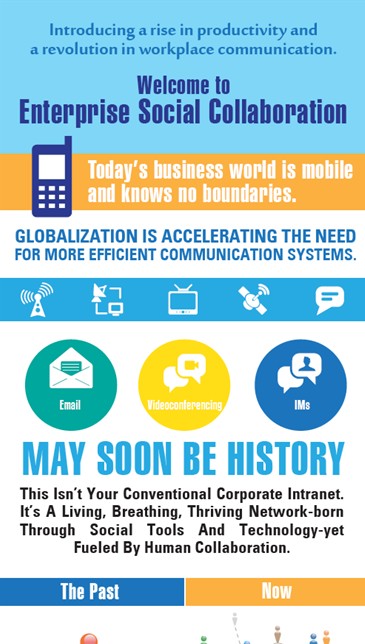The Evolution of Enterprise Social Collaboration

The image to the right is just a small snippet of the whole infographic. Click here to download a full-size version of this infographic.

The image to the right is just a small snippet of the whole infographic. Click here to download a full-size version of this infographic.
Winning Strategies for Power Presentations
by Jerry Weissman
About the Book
Winning Strategies for Power Presentations by Jerry Weissman is a vast collection of presentation best practices focused on gaining and retaining the audience’s attention and effectively conveying the message desired. Jerry takes his presentation lessons from history’s many great orators and presenters. These collections are grouped by topical area including:
Benefits of Reading this Book
All professionals at every organizational level must effectively communicate in order to be successful for it is only through a well conveyed, received, and understood message that we influence others and shape the behaviors around us.
StrategyDriven Contributors like Winning Strategies for Power Presentations because for its thoroughness in addressing each aspect of public presentations. Jerry’s book is well researched and truly gathers the best presentation practices from renowned influencers throughout history. Within his book, we found numerous gems of wisdom, particularly regarding the language and syntax used by successful presenters, that will help us to take our presentation skills to the next level.
We had two criticisms of Jerry’s book. First, while the best practices are contained within well-structured collections there is no overarching process for ‘pulling it all together,’ to create and deliver a powerful presentation. Second, we would have liked to see more and more detailed illustrations of the points Jerry made in the Graphics section of the book; providing a visual example for the points being made.
Winning Strategies for Power Presentations provides readers with a thorough body of best practices needed to elevate their presentation development and delivery skills. Each recommendation is clear and concisely conveyed enabling the reader to quickly select and extract the specific insight needed. For its deep insight and actionable conveyance of how readers can improve a vital business skill, Winning Strategies for Power Presentations is a StrategyDriven recommended read.
How do you communicate?
How good of a communicator are you?
If you want to make a winning sales pitch, it takes a combination of your presentation skills and your communication skills. It’s the little known sales skill: How to get others to listen to you. Or better stated, WANT to listen to you.
SALES TRAINING REALITY: Time is spent on presentation skills, and the presentation itself, but very little or no time is spent on communication skills. Until now.
All your life you heard the lesson: It’s not just what you say, it’s how you say it.
Presentation is what you say.
Communication is how you say it.
The best way to clarify communication skills is to ask you to think about the teachers and professors you had in school. Sometimes the most brilliant ones were the worst communicators – and as a result, left you short of both education and inspiration.
Then think of the teachers you loved. You couldn’t wait to get to their class, and you hung on their every word. In fact, you still remember him or her and you talk about them. They were great communicators.
In sales, great communication skills are one of the lost secrets of success. Sales messages focus around ‘value prop’ and ‘value add’ and other sales drivel. You get a slide deck form marketing, that’s both boring and repetitive – WITH NOT ONE WORD ON HOW TO COMMUNICATE YOUR MESSAGE.
Here are several “wake up” questions to get you thinking about your communication – and I’ll throw in a few challenges:
And the ultimate self-tests of communication:
I TWEETED THIS: A passionate message without clarity will fall on deaf ears. #gitomer #communication
The object of communication, especially sales communication, is for others to UNDERSTAND your message, AGREE with your message, and then TAKE the correct ACTION. Buy.
If you’re really interested in better communication skills, take a course in it. Dale Carnegie (www.dalecarnegie.com) offers the best programs. All of them are based around the 75-year-old business book classic, How To Win Friends and Influence People. It doesn’t get any better than that.
If your communication skills are the heart of your sales message, maybe it’s time to uncover just how strong they are.
Reprinted with permission from Jeffrey H. Gitomer and Buy Gitomer.
About the Author


Hi there! Gain access to this article with a StrategyDriven Insights Library – Total Access subscription or buy access to the article itself.
| Subscribe to the StrategyDriven Insights Library
Sign-up now for your StrategyDriven Insights Library – Total Access subscription for as low as $15 / month (paid annually). Not sure? Click here to learn more. |
Buy the Article
Don’t need a subscription? Buy access to Business Communications Best Practice 4 – Limit Expanding Ambiguity for just $2! |
About the Author


Hi there! Gain access to this article with a StrategyDriven Insights Library – Total Access subscription or buy access to the article itself.
| Subscribe to the StrategyDriven Insights Library
Sign-up now for your StrategyDriven Insights Library – Total Access subscription for as low as $15 / month (paid annually). Not sure? Click here to learn more. |
Buy the Article
Don’t need a subscription? Buy access to Project Management Best Practice 10 – Communication Plans for just $2! |
